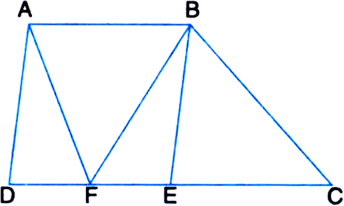Question
The side AB of a parallelogram ABCD is produced to any point P. A line through A and parallel to CP meets CB produced at Q and then parallelogram PBQR is completed. Show that ar(||gm ABCD) = ar(||gm PBQR).
[Hint. Join AC and PQ. Now compare ar(ACQ) and ar(APQ)].

Solution
Given: The side AB of a parallelogram ABCD is produced to any point P. A line through A and parallel to CP meets CB produced at Q and then parallelogram PBQR is completed.


To Prove: ar(|| gm ABCD) = ar(|| gm PBQR). Construction: Join AC and PQ.
Proof: ∵ AC is a diagonal of || gm ABCD![]()
![]() PQ is a diagonal of
PQ is a diagonal of ![]() gm BQRP
gm BQRP![]()
∵ ΔACQ and ΔAPQ are on the same base AQ and between the same parallels AQ and CP. ar(ΔACQ) = ar(ΔAPQ)
∵ Two triangles on the same base (or equal bases) and between the same parallels are equal in area
⇒ ar(ΔACQ) – ar(ΔABQ)
= ar(ΔAPQ) – ar(ΔABQ)
| Subtracting the same areas from both sides ⇒ ar(ΔABC) = ar(ΔBPQ)![]()
| From (1) and (2)
⇒ ar(|| gm ABCD) = ar(|| gm PBQR).







